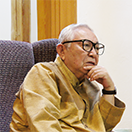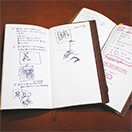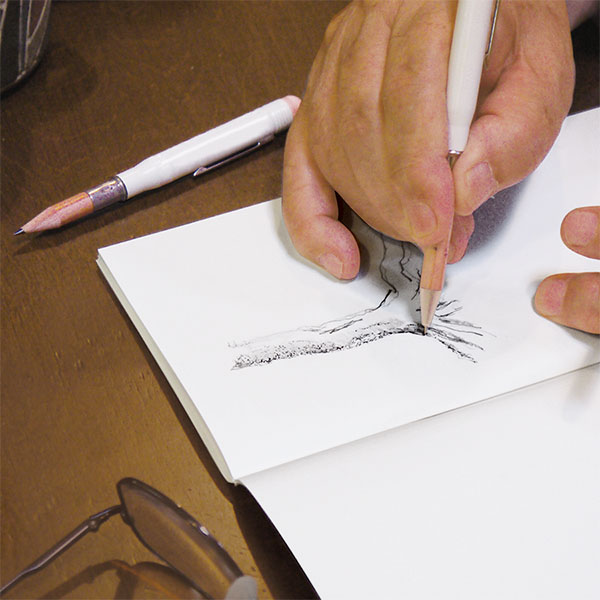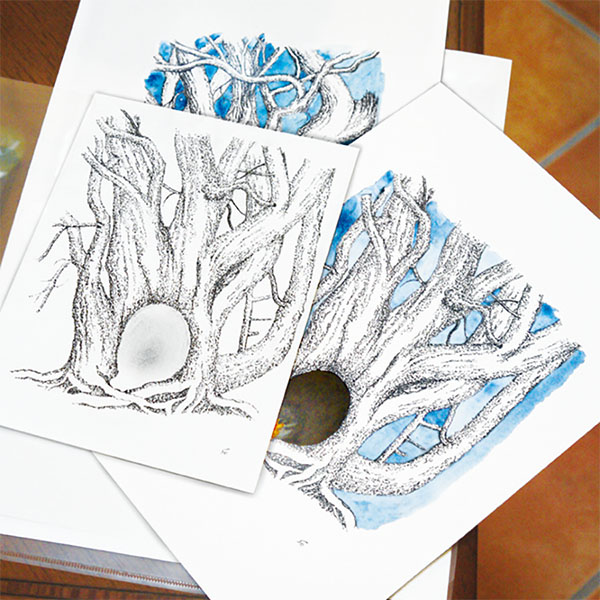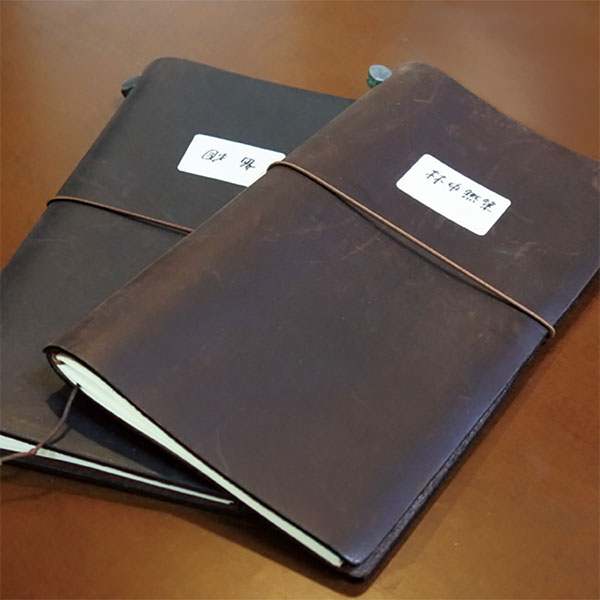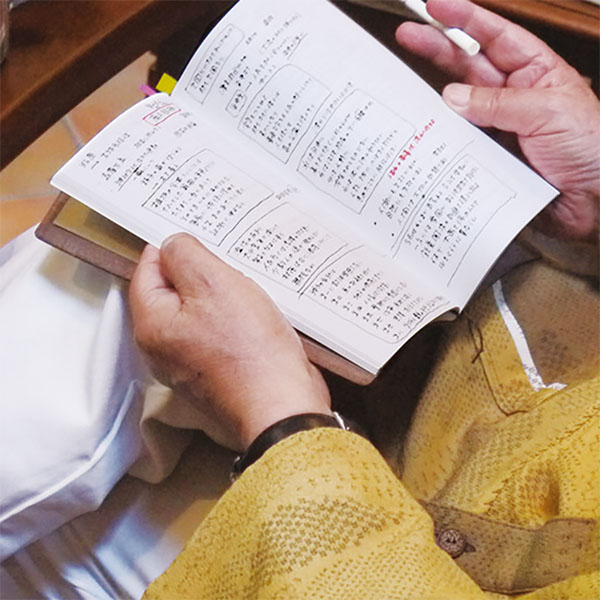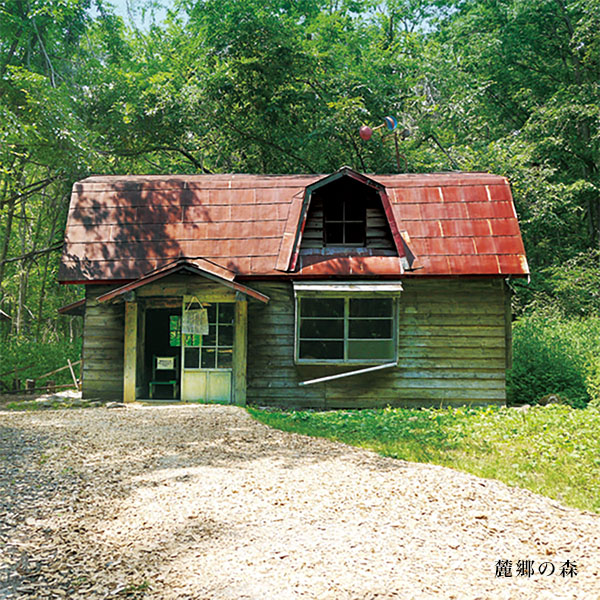So Kuramoto (Script Writer)
倉本 聰(脚本家/富良野GROUP・富良野自然塾主宰)
この革のなんとも言えない肌触りというか、触り心地が好きなンです。
五感の中では、やっぱり視覚が一番強くてよく使われている感覚機能ですよね。その次には聴覚があって、味覚、嗅覚と続いて触覚は最後。でも、触覚がもたらす温もりは、一番大切なような気がするンだなあ。
ぼくはひとつのノートを気に入ると、ずっと同じノートを使い続けるンです。そうやって溜まったノートを整理していて、昔に書いたノートを久しぶりに開いてみると、まずこっちの心に響いてくるのは見た目よりも触感。例えば表紙にタバコの焦げなんかがあったりすると触ってみて、それがとても愛おしく感じるンです。
タイトルを書いたラベルを革の表紙に貼って、演劇やエッセイなど、ひとつの作品ごとに一冊ずつ使うンです。ビジネスマンなどはいろいろ詰め込んで分厚く使っている人も多いと思うけど、ぼくは厚いのは好きじゃないので、カバーに一冊だけノートを綴じるようにしています。常に作品が三、四本並行して流れているので、書斎には使いかけのトラベラーズノートが三、四冊ありますよ。
例えば居間でテレビを見ながら、はっと思いついたことをFAX用紙の裏紙で作ったメモに書き留めておき、夜、書斎でトラベラーズノートを開き、そのメモを書き写したりしながら、新しい発想を書きまとめるンです。
なにか書こうと思った時、ノートをぼんやり見返していると、探していた言葉が突然ひゅっと出てきたりして、そんなことが面白いですね。
そうして、ひとつの仕事が終わるとリフィルを差し替えて、新しいタイトルを書いたラベルを、前のラベルの上にバリバリ貼っていきます。「昨日、悲別で」と書かれたラベルの上に、わざとちょっとずらして「ニングル」のラベルを貼ったりしてね。
日記はどこかで人に見せたり見られたりすることを意識されて書かれているような気がするンです。
昔、勝海舟の大河ドラマのシナリオを書いた時、勝海舟には「海舟日記」という日々のことが事細かに書かれた膨大な日記があって、そういうものが史実として残されていたらドラマとして脚色のしようがないなあと、絶望的な気持ちになったンです。でもよく見たら、勝海舟には8人も付き合っていた女がいたくせに、そのことがいっさい書かれていない。その時に、ああ、これは人に見せるために書いたンだなあ、ということがわかった。
日記っていうのはそういうものなンですね。いいことばっかり書いて、ほんとうのプライベートのコソコソしたことは書かない。
ぼくにとって、トラベラーズノートはコソコソしたことを書くのに適したノート。夜、ひとり書斎で心の中を打ち明けるように書くノートなンです。例えば、どっかのページを探したら、そっと遺言が書いてあって、あいつには遺産を渡すな、とかね(笑)。そんなことが書かれているようなノートですね。
What I really like about this notebook is the feeling you get when touching it.
What I mean is this indescribable texture and feeling when touching the leather cover.
In the five senses that we have, I believe “seeing” is the strongest. Then follows hearing, tasting, smelling, and touching comes in the end. Even though it’s the weakest out of the five senses, I believe the warmth it brings is the most important aspect in our lives.
I have a tendency of using a same notebook for a long time after falling in love with it. After organizing the notebooks I filled in and reading over it, the first thing that intrigues me is the sense of touch. For example, I feel affection towards my notebook that has cigarette burns on the cover.
I use the TRAVELER’S notebook to sketch images of the play I write.
On the leather cover, I paste a label with the title written, and devote the single notebook for a single topic. The topics include plays and essays that come up in my mind. I know business people tend to stuff several refills and use it in a thick fashion, but I’m actually not a big fan of thickness, so I only insert a single refill into the leather cover. There are usually three to four plays proceeding simultaneously, so I have three to four TRAVELER’S notebook in my personal office.
When I’m watching TV in my living room and something flashes through my mind, I would write that down on a back side of a scratch paper. After that, I would go back to my office, open up my TRAVELER’S notebook and copy the rough note I wrote onto the notebook. While copying it down, I organize the flashing ideas that came up to my mind.
What I really enjoy when using this notebook is the fact that the words I was searching for appears in the past notes I wrote. It just pops up suddenly, and I really like that.
When one of my works are done, I would change the refills inside and paste a new label on top of the old one. But I like to play around with the labels a bit, and what I do is paste the new label slightly at a different position compared to the old one. For example, I would paste “Ninnguru” a little off of the label that says “Kinou-Hibetsu-de.”
TRAVELER’S notebook is a notebook that reflects one’s spirit.
I feel that diaries are written based on the assumption that other people would read it.
When I once wrote a script for the drama “Katsu-Kaishu,” I felt devastated when I learned that this Japanese historical figure Katsu wrote a tremendous amount in his diary. If there’s so much information in the diary, then is there any meaning in dramatizing? But when you study Katsu closely, you start to realize that he hasn’t written anything about the eight women he fell in love with. That’s when I realized that he was writing that diary assuming that somebody would read it in the future.
That’s what I think a diary is. You write down the good things, and disregard the true feeling and experiences you had.
For me, TRAVELER’S notebook is a notebook that best suits in writing the true feeling. It’s a notebook you write down alone in your personal space at night. For example, you might find a page that has my will written saying not to leave any fortune to a specific person. It’s a notebook filled with those kind on information.
77年、富良野に移住。84年、役者とライターを養成する富良野塾を創設・主宰(現・富良野GROUP)。
06年、C・C・C富良野自然塾を立ち上げ、閉鎖されたゴルフ場に植樹をして森に返し、そのフィールドを使った教育プログラムにも力を入れている。
代表作に「北の国から」「前略おふくろ様」「昨日、悲別で」「優しい時間」「風のガーデン」など多数。
After graduating University of Tokyo, he joined Nippon Broadcasting System, Inc. He left the job in 1963 and started his career as a scriptwriter. In 1977, he moved to Furano, Hokkaido, and in 1984, he established a school that trains writers and actors. In 2006, he established “C.C.C. Furano,” a nature school that planted trees on a closed golf course. He engages in an educational program that puts an emphasis on the current environment. Some of his major works include “Kita-no-Kuni-Kara,” “Zenryaku-Ofukuro-sama,” “Kinou-Hibetsu-de,” “Yasashii-Jikan,” and “Kaze-no-Kaaten.”




